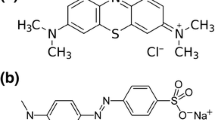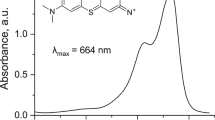Abstract
Sensitization of wide bandgap semiconductors with heterodimers for better solar light sensitivity has attracted widespread attention in the recent times. However, application of heterodimerization for removing soluble water pollutants from waste water is sparse in the literature. In the present study, we have utilized heterodimerization of a model pollutant methylene blue (MB) with a ruthenium based dye N719 for the removal of the pollutant. We have synthesized N719 functionalized carbonate doped TiO2 microspheres (doped MS) which act as a novel material for the detoxification of MB containing water by adsorbing at the surface and eventually killing by photoinduced reduction under visible light irradiation. The mechanism of surface adsorption and photoreduction of MB are explored using steady state and time resolved spectroscopy studies. We have fabricated two types of prototype devices (flow device and active filter) using the functionalized doped MS. Both the devices show excellent dye removal activity and recyclability. The present study would find relevance in the removal of soluble pollutants from waste water.
Similar content being viewed by others
References
W. J. Youngblood, S.-H. A. Lee, K. Maeda and T. E. Mallouk, Visible Light Water Splitting Using Dye-Sensitized Oxide Semiconductors, Acc. Chem. Res., 2009, 42, 1966–1973.
M. Gratzel, Photoelectrochemical cells, Nature, 2001, 414, 338–344.
S. Sardar, S. Sarkar, M. T. Z. Myint, S. Al-Harthi, J. Dutta and S. K. Pal, Role of central metal ions in hematoporphyrin-functionalized titania in solar energy conversion dynamics, Phys. Chem. Chem. Phys., 2013, 15, 18562–18570.
B. E. Hardin, H. J. Snaith and M. D. McGehee, The renaissance of dye-sensitized solar cells, Nat. Photonics, 2012, 6, 162–169.
S. Mathew, A. Yella, P. Gao, R. Humphry-Baker, F. E. CurchodBasile, N. Ashari-Astani, I. Tavernelli, U. Rothlisberger, K. NazeeruddinMd, M. Grätzel, Dye-sensitized solar cells with 13% efficiency achieved through the molecular engineering of porphyrin sensitizers, Nat. Chem., 2014, 6, 242–247.
G. Qin, Y. Zhang, X. Ke, X. Tong, Z. Sun, M. Liang and S. Xue, Photocatalytic reduction of carbon dioxide to formic acid, formaldehyde, and methanol using dye-sensitized TiO2 film, Appl. Catal., B., 2013, 129, 599–605.
M. Pelaez, N. T. Nolan, S. C. Pillai, M. K. Seery, P. Falaras, A. G. Kontos, P. S. M. Dunlop, J. W. J. Hamilton, J. A. Byrne, K. O’Shea, M. H. Entezari and D. D. Dionysiou, A review on the visible light active titanium dioxide photocatalysts for environmental applications, Appl. Catal., B., 2012, 125, 331–349.
C. B. Kc, K. Stranius, P. D’Souza, N. K. Subbaiyan, H. Lemmetyinen, N. V. Tkachenko, F. D’Souza, Sequential Photoinduced Energy and Electron Transfer Directed Improved Performance of the Supramolecular Solar Cell of a Zinc Porphyrin–Zinc Phthalocyanine Conjugate Modified TiO2 Surface, J. Phys. Chem. C, 2013, 117, 763–773.
R. B. M. Koehorst, G. K. Boschloo, T. J. Savenije, A. Goossens and T. J. Schaafsma, Spectral Sensitization of TiO2 Substrates by Monolayers of Porphyrin Heterodimers, J. Phys. Chem. B, 2000, 104, 2371–2377.
A. J. Mozer, M. J. Griffith, G. Tsekouras, P. Wagner, G. G. Wallace, S. Mori, K. Sunahara, M. Miyashita, J. C. Earles, K. C. Gordon, L. Du, R. Katoh, A. Furube and D. L. Officer, Zn–Zn Porphyrin Dimer-Sensitized Solar Cells: Toward 3-D Light Harvesting, J. Am. Chem. Soc., 2009, 131, 15621–15623.
Y. Liu, H. Lin, J. T. Dy, K. Tamaki, J. Nakazaki, C. Nishiyama, S. Uchida, H. Segawa and J. Li, Kinetics versus Energetics in Dye-Sensitized Solar Cells Based on an Ethynyl-Linked Porphyrin Heterodimer, J. Phys. Chem. C, 2014, 118, 1426–1435.
X. Zarate, E. Schott, T. Gomez, R. Arratia-Pérez, Theoretical Study of Sensitizer Candidates for Dye-Sensitized Solar Cells: Peripheral Substituted Dizinc Pyrazinoporphyrazine–Phthalocyanine Complexes, J. Phys. Chem. A, 2013, 117, 430–438.
A. F. Nogueira, L. F. O. Furtado, A. L. B. Formiga, M. Nakamura, K. Araki and H. E. Toma, Sensitization of TiO2 by Supramolecules Containing Zinc Porphyrins and Ruthenium–Polypyridyl Complexes, Inorg. Chem., 2004, 43, 396–398.
Z. S. Seddigi, S. A. Ahmed, S. Sardar and S. K. Pal, Ultrafast dynamics at the zinc phthalocyanine/zinc oxide nanohybrid interface for efficient solar light harvesting in the near red region, Sol. Energy Mater. Sol. Cells, 2015, 143, 63–71.
J. P. Escalada, V. B. Arce, G. V. Porcal, M. A. Biasutti, S. Criado, N. A. García, D. O. Mártire, The effect of dichlorophen binding to silica nanoparticles on its photosensitized degradation in water, Water Resour, 2014, 50, 229–236.
V. Vaiano, O. Sacco, D. Sannino and P. Ciambelli, Photocatalytic removal of spiramycin from wastewater under visible light with N-doped TiO2 photocatalysts, Chem. Eng. J., 2015, 261, 3–8.
N. Nasuha, B. H. Hameed, A. T. M. Din, Rejected tea as a potential low-cost adsorbent for the removal of methylene blue, J. Hazard. Mater., 2010, 175, 126–132.
B. Liu, L.-M. Liu, X.-F. Lang, H.-Y. Wang, X. W. Lou and E. S. Aydil, Doping high-surface-area mesoporous TiO2 microspheres with carbonate for visible light hydrogen production, Energy Environ. Sci., 2014, 7, 2592–2597.
Z.-Q. Li, Y.-P. Que, L.-E. Mo, W.-C. Chen, Y. Ding, Y.-M. Ma, L. Jiang, L.-H. Hu, S.-Y. Dai, One-Pot Synthesis of Mesoporous TiO2 Micropheres and Its Application for High-Efficiency Dye-Sensitized Solar Cells, ACS Appl. Mater. Interfaces, 2015, 7, 10928–10934.
S. Sardar, P. Kar and S. K. Pal, The Impact of Central Metal Ions in Porphyrin Functionalized ZnO/TiO2 for Enhanced Solar Energy Conversion, J. Mater. NanoSci., 2014, 1, 12–30.
S. Sardar, P. Kar, S. Sarkar, P. Lemmens and S. K. Pal, Interfacial carrier dynamics in PbS-ZnO light harvesting assemblies and their potential implication in photovoltaic/ photocatalysis application, Sol. Energy Mat. Sol. Cells, 2015, 134, 400–406.
S. Sardar, P. Kar, H. Remita, B. Liu, P. Lemmens, S. Kumar Pal and S. Ghosh, Enhanced Charge Separation and FRET at Heterojunctions between Semiconductor Nanoparticles and Conducting Polymer Nanofibers for Efficient Solar Light Harvesting, Sci. Rep., 2015, 5, 17313.
R. J. Baxter and P. Hu, Insight into why the Langmuir–Hinshelwood mechanism is generally preferred, J. Chem. Phys., 2002, 116, 4379–4381.
S. Sardar, S. Chaudhuri, P. Kar, S. Sarkar, P. Lemmens and S. K. Pal, Direct observation of key photoinduced dynamics in a potential nano-delivery vehicle of cancer drugs, Phys. Chem. Chem. Phys., 2015, 17, 166–177.
Z. S. Seddigi, S. A. Ahmed, S. Sardar and S. K. Pal, Carbonate Doping in TiO2 Microsphere: The Key Parameter Influencing Others for Efficient Dye Sensitized Solar Cell, Sci. Rep., 2016, 6, 23209.
H. C. Junqueira, D. Severino, L. G. Dias, M. S. Gugliotti and M. S. Baptista, Modulation of methylene blue photochemical properties based on adsorption at aqueous micelle interfaces, Phys. Chem. Chem. Phys., 2002, 4, 2320–2328.
C. Yogi, K. Kojima, N. Wada, H. Tokumoto, T. Takai, T. Mizoguchi and H. Tamiaki, Photocatalytic degradation of methylene blue by TiO2 film and Au particles-TiO2 composite film, Thin Solid Films, 2008, 516, 5881–5884.
A. Mills and J. Wang, Photobleaching of methylene blue sensitised by TiO2: an ambiguous system?, J. Photochem. Photobiol., A, 1999, 127, 123–134.
Author information
Authors and Affiliations
Corresponding authors
Rights and permissions
About this article
Cite this article
Seddigi, Z.S., Ahmed, S.A., Sardar, S. et al. Heterodimerization at the dye sensitized TiO2 surface: an efficient strategy toward quick removal of water contaminants. Photochem Photobiol Sci 15, 920–927 (2016). https://doi.org/10.1039/c6pp00071a
Received:
Accepted:
Published:
Issue Date:
DOI: https://doi.org/10.1039/c6pp00071a




